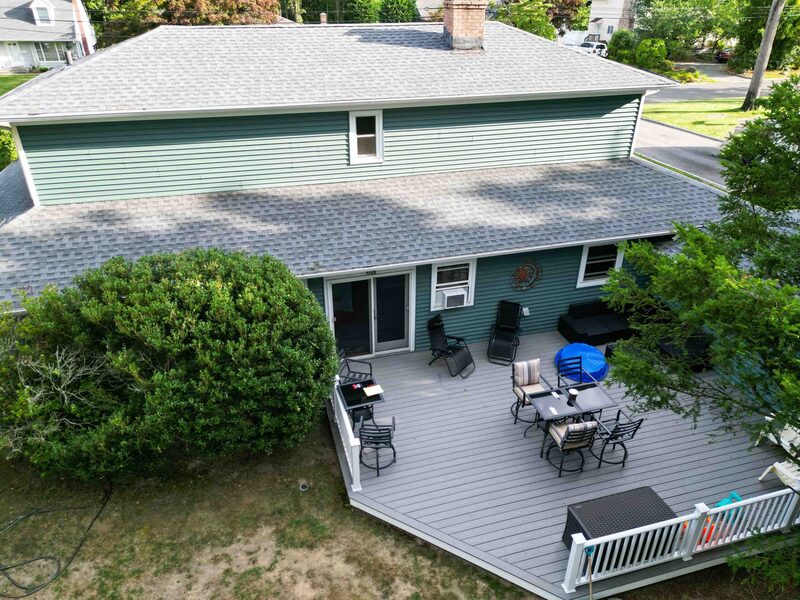Multi-Tier Deck: Elevate Your Outdoor Living
A multi-tier deck is not just a structure; it’s a statement. It reimagines the potential of your outdoor space, creating layered zones for different activities while adding a touch of architectural flair. Unlike single-level decks, which can feel flat and uninspired, a multi-tier deck leverages vertical space, transforming uneven or sloped yards into dynamic environments.
Picture this: an upper-level deck hosting a cozy lounge area with plush seating and a fire pit, while a lower tier serves as an open-air dining space perfect for entertaining under the stars. These decks seamlessly blend form and function, making them ideal for both large gatherings and intimate family moments. Multi-tier decks aren’t just about maximizing space—they’re about creating an outdoor sanctuary tailored to your lifestyle.
Multi-Level 2-Tier Deck Designs: Building Layers of Luxury
A multi-level 2-tier deck design is the sweet spot of outdoor living, offering two distinct yet connected spaces that cater to various needs. These decks are perfect for homeowners looking to elevate their backyard experience—literally and figuratively.
Ideas for Two-Tier Deck Designs
- Zoned Living Spaces: Dedicate the upper tier to relaxation with chaise lounges and shade-providing pergolas, while the lower tier becomes a functional hub with a dining table and built-in grill.
- Flowing Water Features: Enhance the connection between tiers with a cascading water feature, creating a tranquil ambiance while visually linking the levels.
- Statement Railings: Use contrasting materials, like black aluminum or tempered glass, to define the space while maintaining an unobstructed view.
- Multi-Directional Decking Patterns: Add visual interest by laying decking boards in different patterns on each level—herringbone on one and traditional on the other.
- Integrated Lighting: Incorporate LED lights into the steps, railings, and even under the tiers for a stunning effect after sunset.
The beauty of 2-tier deck designs lies in their versatility. They create harmonious transitions between spaces while allowing homeowners to explore bold, personalized design choices.
Multi-Tier Shared Deck Post: Strength and Style in Harmony
The multi-tier shared deck post is a marvel of engineering and design. This structural element serves as the backbone of multi-tier decks, offering both stability and visual continuity across levels. By using shared posts, designers can streamline the deck’s appearance while ensuring it remains robust and safe.
Benefits of Shared Deck Posts
- Enhanced Stability: Shared posts distribute weight evenly, reducing the risk of sagging or instability over time.
- Cost Efficiency: Fewer posts mean lower material costs and less groundwork, making this approach budget-friendly without compromising quality.
- Unified Design: A shared support system creates a cohesive look, ensuring that all tiers feel connected and intentional.
For homeowners aiming to combine functionality with aesthetics, multi-tier shared deck posts are an essential feature.
Multi-Tier Deck Designs: Trends for 2025
As outdoor living continues to evolve, multi-tier deck designs are stepping up—literally. The trends for 2025 emphasize personalization, sustainability, and the seamless integration of nature with modern comforts.
Top Deck Trends for 2025
- Eco-Friendly Materials: Decking made from recycled composites or sustainably sourced wood is becoming the gold standard for environmentally conscious homeowners.
- Curved Designs: Forget sharp edges—soft, curved tiers add an organic flow that mimics natural landscapes.
- Smart Features: Built-in USB charging ports, Wi-Fi boosters, and weather sensors are turning decks into tech-savvy outdoor hubs.
- Natural Blending: Multi-tier decks are incorporating greenery through integrated planters, vertical gardens, and tree-friendly cutouts.
- Split-Level Pool Decks: These designs seamlessly integrate pools with multi-tier decks, offering lounge spaces, shaded areas, and poolside dining all in one.
These trends highlight how multi-tier decks can be as innovative as they are beautiful, allowing homeowners to craft spaces that are as functional as they are inspiring.
Multi-Tier Deck Ideas 2025: Creative Concepts for Every Space
Looking for fresh multi-tier deck ideas for 2025? Let your imagination soar with these creative concepts that redefine outdoor living.
Innovative Deck Concepts
- The Entertainment Complex: Design tiers with specific purposes—one for lounging, one for dining, and another for games or activities. Include features like an outdoor bar or a movie projector for added fun.
- Hidden Retreats: Incorporate cozy nooks or secluded seating areas into the design, perfect for quiet moments away from the crowd.
- Natural Elements: Blend the deck with its surroundings by using natural stone accents, water features, or even incorporating existing trees into the structure.
- Seasonal Adaptability: Plan for year-round use with features like built-in heaters, retractable canopies, and weatherproof furniture.
- Outdoor Fitness Zone: Dedicate a tier to wellness with a yoga deck, an outdoor gym setup, or even a hot tub for post-workout relaxation.
With thoughtful planning, a multi-tier deck can become a personalized oasis that caters to every whim and season.
Multi-Tier Deck vs. Single-Level Deck
Deciding between a multi-tier deck and a single-level deck requires careful consideration of your yard’s layout, your lifestyle, and your design goals. Here’s a side-by-side comparison to help you choose:
Functionality
- Multi-tier decks offer separate zones for different activities, making them perfect for larger gatherings or families with diverse needs.
- Single-level decks provide a simple, open space ideal for smaller yards or straightforward uses.
Space Utilization
- Multi-tier decks maximize vertical space, making them ideal for sloped yards or properties with uneven terrain.
- Single-level decks are best suited for flat areas where a unified space is preferred.
Aesthetic Appeal
- Multi-tier decks add drama and visual interest, becoming a centerpiece of the backyard.
- Single-level decks offer clean, minimalist lines that work well with modern architecture.
Each type of deck has its merits, but multi-tier designs stand out for their ability to transform ordinary yards into extraordinary spaces.
Frequently Asked Questions
What is a multi-tier deck, and how does it enhance outdoor spaces?
A multi-tier deck is a layered outdoor structure that features multiple levels connected by stairs or ramps. It enhances outdoor spaces by creating distinct zones for various activities, such as dining, lounging, or entertaining. Multi-tier decks are particularly effective in sloped yards, as they make otherwise unusable areas functional while adding architectural beauty.
How do you build a multi-tiered deck?
Building a multi-tiered deck involves:
- Assessing the yard’s slope and layout to determine the best placement for each tier.
- Designing a layout that incorporates stairs, railings, and support systems.
- Installing deep footings to anchor the structure securely.
- Framing and constructing each level, ensuring proper alignment and stability.
- Adding finishing touches like decking boards, lighting, and railings.
Hiring a professional is often recommended for multi-tier projects due to their complexity.
How much does a multi-level deck cost?
The cost of a multi-level deck varies widely based on size, materials, and features:
- A basic multi-tier deck can start at $20,000 to $30,000.
- High-end designs with premium materials, built-in features, and intricate layouts can exceed $60,000.
Additional costs may include permits, landscaping, and custom details.
How many types of decks are there?
There are several types of decks, including:
- Single-Level Decks: Simple, flat structures ideal for small spaces.
- Multi-Tier Decks: Multi-level designs that create dynamic outdoor areas.
- Freestanding Decks: Detached structures that can be placed anywhere in the yard.
- Rooftop Decks: Built on flat roofs for urban living.
- Wraparound Decks: Decks that encircle part or all of a home.
Each type serves different purposes, catering to various yard layouts and homeowner needs.
How do you plan a deck layout?
Planning a deck layout involves:
- Defining the deck’s purpose, such as entertaining, dining, or relaxing.
- Measuring the yard and sketching a scaled design.
- Selecting materials that suit the climate, budget, and aesthetic preferences.
- Incorporating features like stairs, railings, or built-ins.
Ensuring the design complies with local building codes.
Professional guidance can help optimize the layout for functionality and aesthetics.

